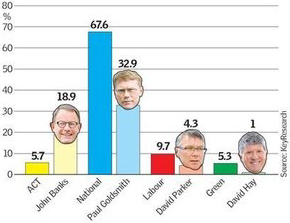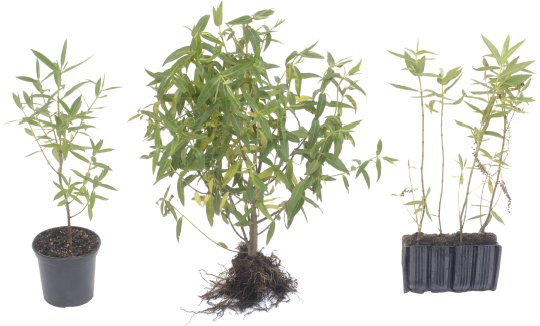Party-vote green growth for a richer Aotearoa

Rich Pickings: It may have taken 21 years, but Green Party marketing has finally caught up with New Zealanders’ aspirations to be green and productive. At this rate, the third party could beat languishing Labour out of second place by the 2014 election. image The Green Party of Aotearoa/New Zealand
In Australia, the party is simply called Australian Greens, or The Greens for short.
In Aotearoa it is ‘The Greens, The Green Party of Aotearoa/New Zealand’, which at 51 characters including spaces and punctuation is just one short of the 52-character maximum. Fortunately, it is legal to use the short form (Green Party) on ballot papers, but in the past, laboriously, it has been the full 51 characters.
With Green’s recent embrace of green growth, the party would benefit by from adopting that succinctly descriptive phrase as its short-form name. But while its election pamphlet is adroitly captures the green growth message—
For a richer New Zealand party-vote Green
—the party’s election hoardings appear to have been produced before the decision was made to accentuate the economic positives of going green.

Way to Grow: Although it is polling at up to 11.5%, the Herald on Sunday’s Key Research poll of 500 Epsom voters shows that other issues can heavily impact on the percentage prepared to vote Green. The good news: That unpleasant reminder of the ruinously destructive Rogernomics era, the Act Party, is facing long-overdue electoral oblivion. Graphic Herald on Sunday
The hoardings do, however, focus on the singular importance of the party vote, in mixed member proportional elections. In previous elections, the party has bled significant support as a result of folk with green sympathies voting for Green candidates but giving their party vote to Labour. Seven weeks from the election, in the face of an almost unprecedentedly popular Prime Minister, John Key, it appears that many Green Party supporters are deciding that Labour, with its stubborn insistence on sticking with an uncharismatic party hack, is a lost cause for the foreseeable future. Consequently, Labour rather than Green is likely to be the recipient of any electorate sympathy votes—certainly Green-candidate-in-the-red-corner Christine Rose is an attractive option for green Rodney Electorate voters.
In the three months since it was launched, green growth lobby group Pure Advantage has amassed almost 6000 members, which is about three times as many as the Green Party has taken 21 years to garner—or 39 years, if dated from the birth of the Values Party. Along with its recent uplift in the various polls, it would be an entirely healthy development if the Green Party was to grow its membership at a similar rate. But not only the Greens, all parties need to build their membership base—it is deeply undemocratic for party policy to be written by parties with a combined membership of about 3% of registered voters.
While the rise of Pure Advantage has been rapid, it has slowed recently and is at risk of stalling. Along with Labour, it lacks a charismatic spokesman. The Mahurangi Magazine’s answer (admittedly, its answer to most things) is the iconic Lucy Lawless. The Green Party likewise dearly needs to attract a ready-made media magnet, and to ditch the ditsy his ’n hers co-leadership model. Political parties are universally distrusted. Which, in part at least, is why political outsider John Key is so warmly embraced. And is why Green Party leaders should strenuously avoid the appearance of ritually opposing every government measure.
Regarding compelling leadership attributes, the mixture of maths, science, engineering and technology that Dr Daniel Mūllensiefen and Alisun R Pawley have found makes for the most sing-along-able song is potentially instructive:

Championship Ingredients: High chest voice, vocal effort, clear consonants, less melisma and embellishment, and male singer were found to be the musical attributes that explain the popularity of Freddie Mercury’s performance of We Are the Champions in 1050 sing-along events studied. image Press Association
Singing along is positively influenced by these musical factors:
- High chest voice
- More vocal effort
- Clearer consonants
- Less melisma and embellishment
- Male singer.
This possibly means that for female and male voters alike, warrior princesses notwithstanding, male leaders will generally be found to be more follow-able than female. Otherwise, the need to be telegenic is a given, and Rodney Hide is living proof that this covers a wide phenotypical spectrum—although not so broad as to accommodate the Mr Magoo-ish Dr Brash.
While awaiting a leader who can evoke the subconscious war cry Dr Mūllensiefen speaks of, the Green Party is concentrating on marketing resonant policies. Clinically, the party’s pamphlet focuses on just three:
- Bringing 100 000 kids out of poverty
- Making our rivers clean enough to swim in again
- Stimulating thousands of green jobs.
For the party with a policy on everything, this display of restraint is exemplary.
One fold of the pamphlet, however, has been devoted to the referendum on mixed member proportional. While a little wordy, the main message is straightforward:
- MMP can be improved. Let’s keep it, review it, and make our democracy even stronger.
- No other system delivers all the benefits that MMP provides.

Greater Growth: Increasing the resilience of coastal and riparian margins calls for literally billions of trees to be planted in Aotearoa alone. Open-ground plants (middle plant) trialled in the Mahurangi catchment have demonstrated that, even on a small scale, this forestry-style method is the smarter, more cost-effective solution. photographer Jonathan Barran
Without a fully proportional electoral system, not only would there be no party to champion green growth policies, Aotearoa would still be in the thrall of the deeply undemocratic duopoly that sidelined women and Māori, until 1996. None of the options offered in the second part of the referendum can hold a candle to the mixed member system. And, with the single most cynical manipulator of the system (not) in the game, Winton Peters, out-charmed by John Key, mixed-member-proportional will ensure a continuation of the stable, collaborative government that the electorate deserves.
While the embrace of green growth is constructive, in years to come the Green Party will have reason to feel ashamed that its 2011 election pamphlet resiled from referring directly to global warming, or any of the euphemisms for the anthropogenically enhanced greenhouse effect. Aside from the obligatory sprinkling of the words renewable and sustainable, the strongest statement is:
Transitioning to a low-carbon sustainable economy presents a new opportunity for New Zealanders.
After four decades of increasingly urgent scientific warnings of the danger of anthropogenic global warming, and with a clear escalation in the frequency and severity of extreme weather events, and with Pacific nations paying an early and brutal toll, the time for apologetic language has long past. The mobilisation involved in de-coupling from fossil fuels is mammoth. The mobilisation necessary to protect and relocate low-lying infrastructure is mind- and budget-boggling. And the mobilisation needed to increase the resilience of riparian margins can literally be measured in billions of trees.
Call it climate action or call it green growth, there is clearly work for everybody.

Hi Climate-Concerned Green Voters
I have a pile of these beautiful Greens hoardings in sizes to suit your front fence. If you would like one, let me know via Cimino.